
International Journal of Leading Research Publication
E-ISSN: 2582-8010
•
Impact Factor: 9.56
A Widely Indexed Open Access Peer Reviewed Multidisciplinary Bi-monthly Scholarly International Journal
Plagiarism is checked by the leading plagiarism checker
Call for Paper
Volume 6 Issue 4
April 2025
Indexing Partners



















Creating Modular and Reusable Web Components with React
| Author(s) | Mariappan Ayyarrappan |
|---|---|
| Country | United States |
| Abstract | React has emerged as a dominant library for building interactive and reusable web interfaces. Its component-based architecture allows developers to break down complex UIs into modular pieces that can be composed, tested, and maintained independently. This paper explores fundamental principles for creating reusable and modular web components using React. We discuss key patterns such as Higher-Order Components (HOCs), custom hooks, composition through props, and effective state management. Various diagrams (flowcharts, state diagrams, bar charts, etc.) illustrate best practices and demonstrate how teams can streamline development through consistent, maintainable design. We also examine the organizational benefits—reduced duplication, faster iteration, and more cohesive user experiences—of adopting a component-first mindset. |
| Keywords | React, Web Components, Modular Architecture, Reusability, JavaScript Frameworks, UI Composition |
| Field | Engineering |
| Published In | Volume 2, Issue 5, May 2021 |
| Published On | 2021-05-04 |
| Cite This | Creating Modular and Reusable Web Components with React - Mariappan Ayyarrappan - IJLRP Volume 2, Issue 5, May 2021. DOI 10.5281/zenodo.15051110 |
| DOI | https://doi.org/10.5281/zenodo.15051110 |
| Short DOI | https://doi.org/g88zx6 |
Share this


CrossRef DOI is assigned to each research paper published in our journal.
IJLRP DOI prefix is
10.70528/IJLRP
Downloads
All research papers published on this website are licensed under Creative Commons Attribution-ShareAlike 4.0 International License, and all rights belong to their respective authors/researchers.

